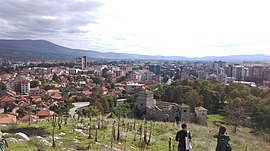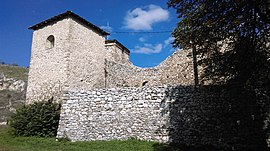Pirot
Град Пирот (Serbian) | |
|---|---|
| City of Pirot | |
|
From top: Panoramic view of Pirot, Pirot Central Square, Museum Old House, Pirot Town Hall, Pirot Courthouse, Pirot Fortress | |
 Location of the city of Pirot within Serbia | |
| Coordinates: 43°10′N 22°36′E / 43.167°N 22.600°E | |
| Country | |
| Region | Southern and Eastern Serbia |
| District | Pirot |
| City status | March 2016 |
| Settlements | 72 |
| Government | |
| • Mayor | Vladan Vasić (SNS) |
| Area | |
| • Rank | 5th |
| • Urban | 29.53 km2 (11.40 sq mi) |
| • Administrative | 1,232 km2 (476 sq mi) |
| Elevation | 367 m (1,204 ft) |
| Population (2022 census)[2] | |
| • Urban | 34,942 |
| • Urban density | 1,200/km2 (3,100/sq mi) |
| • Administrative | 49,601 |
| • Administrative density | 40/km2 (100/sq mi) |
| Time zone | UTC+1 (CET) |
| • Summer (DST) | UTC+2 (CEST) |
| Postal code | 18300 |
| Area code | +381(0)10 |
| Car plates | PI |
| Website | www |
Pirot (Serbian Cyrillic: Пирот) is a city and the administrative center of the Pirot District in southeastern Serbia. According to 2022 census, the urban area of the city has a population of 34,942, while the population of the city administrative area has 49,601 inhabitants.
The city has rich geographical features, including the mountains of Stara Planina, Vlaška Planina, Belava, Suva Planina; rivers which flow through the town, including Nišava, Jerma, Rasnička Reka, Temštica and the Visočica; and four lakes, the Zavoj Lake, Berovacko Lake, Krupac Lake and Sukovo Lake.
It also has a rich culture, with notable Orthodox church buildings, including the Church of St. Petka, and the monastery of St. Georges and St. John the Theologian from the late 14th century, both of which display an example of medieval architecture. Pirot is known for its traditional woven carpet, the Pirot carpet (Pirot ćilim).[3]
- ^ "Municipalities of Serbia, 2006". Statistical Office of Serbia. Retrieved 2010-11-28.
- ^ "2022 Census of Population, Households and Dwellings: Ethnicity (data by municipalities and cities)" (PDF). Statistical Office of Republic Of Serbia, Belgrade. April 2023. ISBN 978-86-6161-228-2. Retrieved 2023-04-30.
- ^ "[Project Rastko] THE HISTORY OF SERBIAN CULTURE - Miroslav Fruht: Applied art and design".






